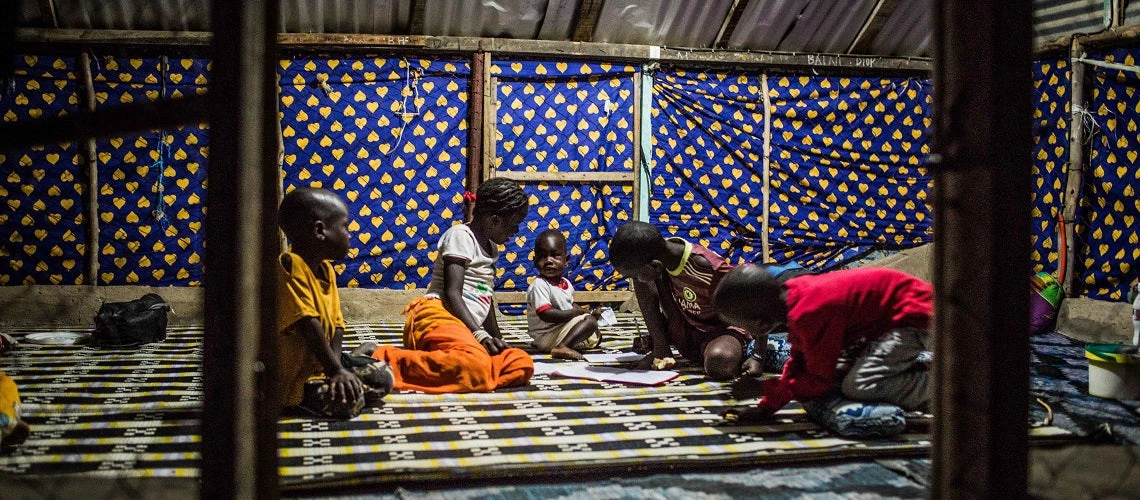 Children study inide the family house at night time, in Diadiam 3 village, region of Saint Louis, Senegal, thanks to the electricity that was installed. Photo: Vincent Tremeau/The World Bank
Children study inide the family house at night time, in Diadiam 3 village, region of Saint Louis, Senegal, thanks to the electricity that was installed. Photo: Vincent Tremeau/The World Bank
To achieve resilient and decarbonized development, countries will need major structural and policy change, and investments. By our own estimates, extrapolated from our published Country Climate and Development Reports (CCDRs), low- and middle-income countries (without China) will need to invest around $783 billion between now and 2030, and that’s only part of what’s needed for broader development objectives. Other estimates to achieve the SDGs are even higher. Obviously a very tall order.
But the focus on the need for countries to spend more on their development should not obfuscate another key requisite for success: countries can and need to spend better.
"But the focus on the need for countries to spend more on their development should not obfuscate another key requisite for success: countries can and need to spend better."
The potential for countries to spend better is enormous. By recent estimates, a World Bank report Detox Development finds that countries spend more than $1.2 trillion on subsidies toward energy, water, and agriculture. These are inefficient at best, and often significantly counterproductive. Such subsidies were typically introduced to support worthwhile policy goals, from making energy affordable for the poorest and supporting industrial competitiveness to helping farmers make a decent living and providing affordable food to all. But they often fail to achieve their well-intentioned goals, and come at a high cost in terms of efficiency, equity and the environmental costs that they impose on their countries.
Energy subsidies should help poor people access modern energy. So it should follow that by simply removing them, this would hurt poor people. But because rich people spend much more on energy than do poorer people, they get the lion’s share of these benefits. Moreover, artificially low energy prices discourage all efforts to prevent waste and improve energy efficiency.
It's the same for firms. Big firms tend to capture most of the subsidy, but all businesses get stuck in inefficient technological choices. This explains why when Mexico, Indonesia, and Oman removed energy subsidies they saw increased productivity and competitiveness.
So what should governments do? Instead of trying to boost competitiveness and increase energy access through artificially low energy prices, governments can use better tools. For energy access, governments could replace a uniform price subsidy by a targeted cash transfer to help poor people buy energy. To boost competitiveness, they can reform their tax system, or invest in what makes economies competitive, such as skilled and healthy workers, reliable and efficient infrastructure systems, efficient bureaucracy and tax collection, or a well-enforced rule of law.
These tools will do more to help the poor and vulnerable, they will increase productivity and competitiveness and incentivize efficiency. And the best part: they will cost less, making it possible to use scarce resources for other important development goals, from health to infrastructure, or for making public finance sustainable without painful cuts in social spending and investments.
Agricultural subsidies fall into similar traps. Helping farmers is essential but doing it through subsidized fertilizer prices is very costly, and sometimes even counterproductive, leading to lower yields due to overuse. It also leads to impacts on water, air pollution, with significant health impacts as well as aggravating climate change. The same resources, directed instead toward improving agricultural practices and productivity, or in the form of payment for ecosystem services, would do more to help farmers, and lead to better economic, social, financial, and environmental outcomes.
"Agricultural subsidies fall into similar traps. Helping farmers is essential but doing it through subsidized fertilizer prices is very costly, and sometimes even counterproductive, leading to lower yields due to overuse."
Because natural hazards often damage roads, power lines and water infrastructure and are a leading cause of economic disruptions, we also estimate that low- and middle-income countries are losing $100 billion per year by not building their new infrastructure to the adequate resilience standards. These losses could be incurred from higher repair costs, especially in the transport sector, to economic losses from infrastructure disruptions for road closure to water and power outages. Practices that are commonly implemented in countries like Japan or the Netherlands could make infrastructure more reliable and resilient and need not cost significantly more. We estimate it would only cost 3% more when assets are built, with $4 in benefits per $1 in investment. And it is well documented that poor governance and budget management lead many countries to underspend on the maintenance of their existing infrastructure, making overall costs balloon: by our estimates, every additional $1 spent on maintenance reduces the need for new investments by $1.5.
Our country climate and development reports also show that in many countries – from Ghana and Iraq to Brazil and Türkiye – the current and planned power systems are far from the least-cost option as they do not use the full potential for cheap renewable energy. Increased investments in solar and wind power would reduce electricity costs and prices. But doing so would require investing in power system planning and the institutions and market regulations needed to integrate more renewable in the grid. Kenya is an example of a country where reforms of the power utility and energy markets increased the share of renewable energy while boosting private investment and power generation capacity, showing the potential of policy changes.
A last example: unmanaged urban growth and sprawl magnify investment needs in electricity, transport, and water and sanitation, continue to increase the share of population living in flood risk areas. And poor procurement and lack of competition in public works inflate the unit cost of infrastructure. In many countries, such as Türkiye, shifting from renewable feed-in tariffs to more competitive processes such as auctions has reduced costs dramatically. Here again, policies matter: our work suggests that implementing better policies could halve the investment needed in infrastructure to achieve the SDGs.
"Policies matter: our work suggests that implementing better policies could halve the investment needed in infrastructure to achieve the SDGs."
If these policies make so much sense, why haven’t they been implemented yet? Political economy challenges are a key barrier: entrenched interests could lose out if spending is directed more efficiently. But there is another challenge: capacity. Many governments use price subsidies to help populations, especially after a shock, because it is simple to implement, has minimal transaction costs, and does not require a lot of data and institutional capacity. Shifting to more efficient systems will take more sophisticated systems and better data, but becomes easier and cheaper thanks to new digital technologies.
Shifting from energy price subsidies to targeted cash transfer requires countries to have household registries, social protection systems, and appropriate delivery mechanisms. A study in Latin America shows how difficult it is: In Ecuador, Chile, Colombia, and Uruguay, 3 to 4% of the population are both among the poorest 20 percent in their country and the 20 percent most affected by an increase in energy price but are not covered by any existing social protection system. Protecting this population would require the development of better – broader and more responsive – systems.
Ensuring transport infrastructure assets are built according to risk-sensitive standards – that is, built more robustly where natural hazards are expected to strike, or for key critical assets – require that natural hazard data exists and that it is usable, that appropriate construction standards exist to decide how robust each asset should be, that construction companies are able to successfully implement the higher-resilience practices, and that the public authorities can enforce the regulation and monitor results. Again, this requires institutional and technical capacities that many countries lack.
Building these systems is not very expensive compared with the total investment needs, but it still requires human and financial resources. Building these capacities and systems is what development is about, and what the World Bank is doing.
To facilitate price reforms and protect vulnerable populations, the government of Egypt strengthened the country’s social protection mechanisms, namely the Takaful and Karama cash transfer programs, with World Bank support. Drawing on data from a proxy means-testing questionnaire cross-checked with a unified national registry, linked with a unique identification number, the government is able to ensure the most vulnerable are supported through the energy transition. Even though investing in these systems is not considered climate change mitigation, there can be no ambitious climate change mitigation without it.
In Mozambique, recent World Bank projects have supported the development of the government’s Road Asset Management System with the inclusion of the Climate Resilient Planning Tool to identify vulnerable areas and protect road assets by designing resilient interventions to manage the resources in a more predictable and systematic way.
To support resilient and low-carbon development, our country climate and development reports identified priorities for action, and estimated investment needs to meet these from a range of sources. But they also emphasized the many changes in policies and regulations to help countries spend better the resource they already have. Actually, most of their recommendations are about policy reforms and institutional change, meant to improve the efficiency of spending and to redirect – rather than increase – government spending.
Without underestimating investment needs, which are an important piece of the puzzle, it would be a major missed opportunity to reduce the climate and development challenge to a financing problem, and focus so much on how to spend more that we forget the opportunities to spend better.



Join the Conversation